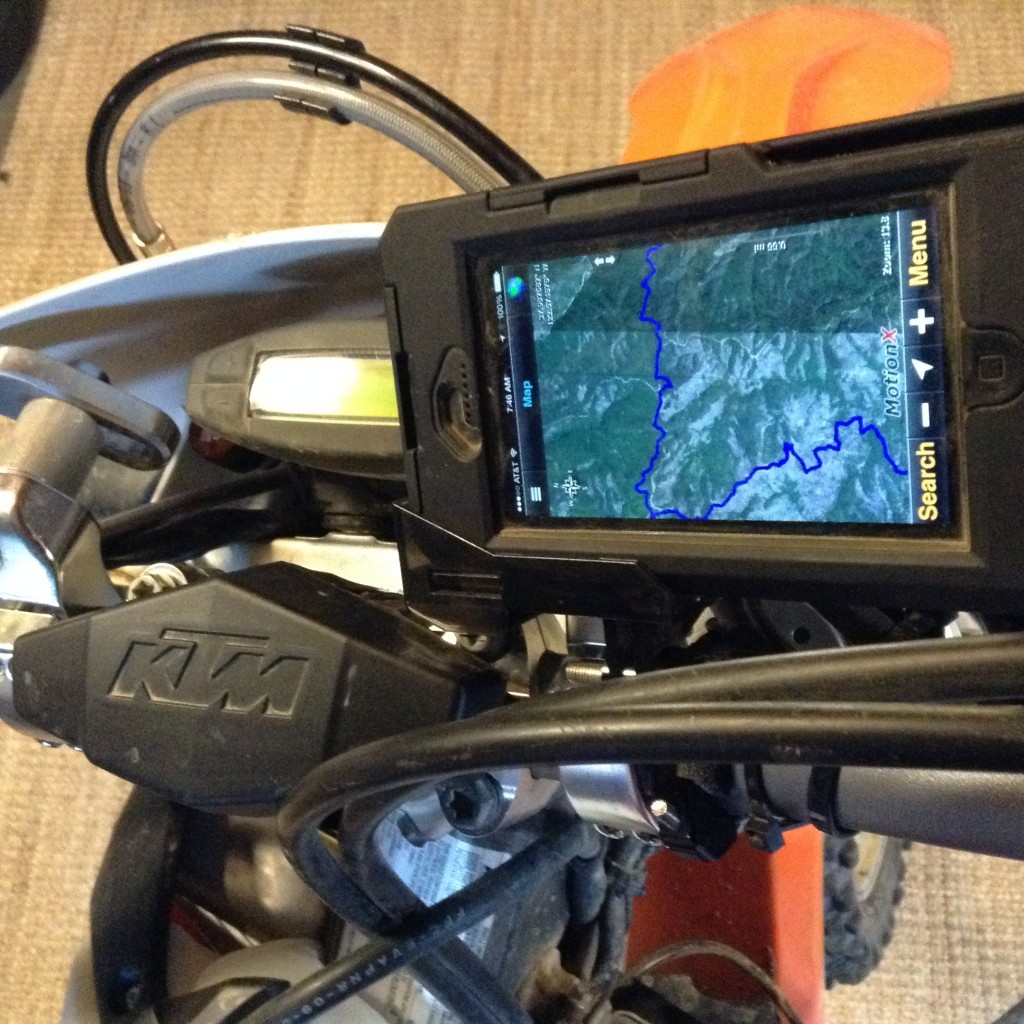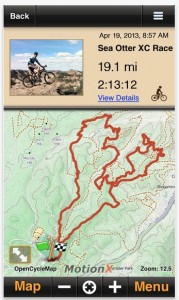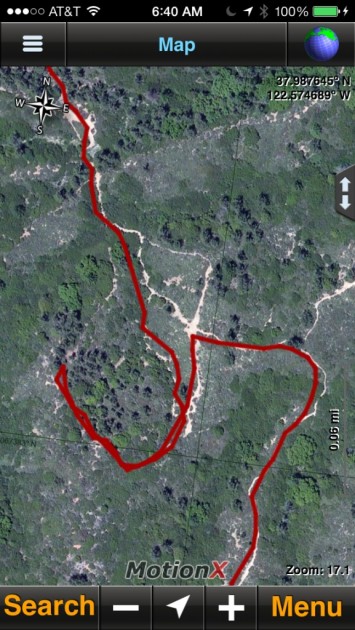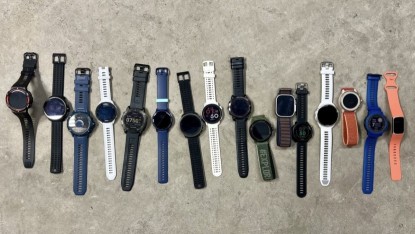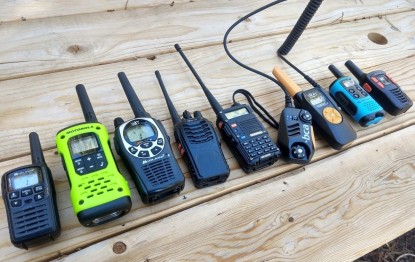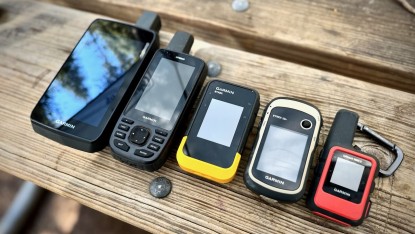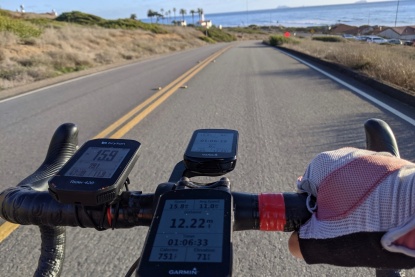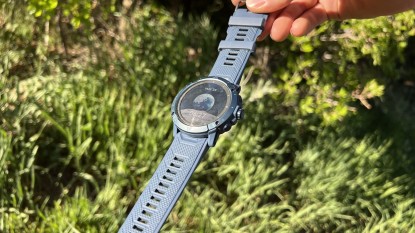What is the best cheap motorcycle GPS you can buy in 2019? It's hard to beat the value of turning your smartphone into a GPS through a burly phone mount. Here is how to make an effective GPS replacement for your bike or motorcycle for under $100. For most people, an iPhone (or Android phone) will work like a GPS. All you need is a solid mount and power source, as we describe below. Scroll to the bottom of the article for Pros and Cons of a standard GPS vs. an iPhone as a GPS.
There are five key parts of a cheap motorcycle GPS:1) Smartphone
2) GPS App
3) Bar mount and burly case
4) Backup power source or battery to USB charger
5) And, of course, tracks to follow
1) SmartphoneJust about any smartphone will work as long as there are mounts that support it. Often the newest phones can face a delay of 3-9 months until the new cases catch up. Older phones are fine, but make sure the battery is still holding a charge. While you should have a battery backup and a way to charge your phone, it's a good “backup of your backup” to have long battery life.
The iPhone works well. More importantly, MotionX GPS is not available on Android. This forum thread at ADVrider.com has some suggestions for Android users. Another popular app for both Android and iPhone is GAIA GPS.
2) GPS App - MotionX GPS- You can easily load tracks. Those directions only work for .gpx files. If someone sends you a Garmin .gdb file, you will need to convert it to .gpx. This tutorial shows three ways. However, the first way says to use MapSource, which only works on Windows computers. For Macs, follow the same instructions (using Garmin BaseCamp. )
- You can download many layers, including topo maps, aerial photos, etc. and most importantly, save them on your phone for offline use.
We pre-download three layers for offline use:
- Motion X Terrain (shows many OHV trails)
- Satellite Imagery
- USGS Topo Maps (shows much more detailed contour lines than Motion X Terrain and old 4 x 4 roads)
NOTE: MotionX does not automatically come with satellite or USGS Topo maps that can download for offline use. You need to follow these steps:
1) In the MotionX app, go to Setup and then Purchases. Purchase the ability to add custom map urls for a fee.
2) Follow the steps at this article . It's written for the MotionX HD iPad app but 90 percent of the instructions work for iPhones. Use your intuition for the other 10 percent.
3) The satellite maps source I use is USGS World. You will need to cut and paste this URL into MotionX http://services.arcgisonline.com/ArcGIS/rest/services/World_Imagery/MapServer/tile/[Z]/[Y]/[X].
for USGS Maps, I use USA Topo and this URLhttp://services.arcgisonline.com/ArcGIS/rest/services/USA_Topo_Maps/MapServer/tile/[Z]/[Y]/[X]
Be very careful when cutting and pasting the URL. Just one incorrect character and you will get the dreaded “no map data” screen.
Where to store tracks?I use Google Drive to organize tracks. With the Drive App for iPhone/iPad, hold your finger down on the file and a window pops up giving you the option to open that file in MotionX GPS). You can also email yourself files and open them from your phones mail app. We cover both options with a visual guide in our article on how to load GPX files on your phone.
The Importance of Offline UseWhen you need MotionX the most, you may not have internet access. It's crucial to have maps downloaded before your ride and that you downloaded the right amount of detail (the app default saves storage space by downloading fewer tiles - we recommend downloading as much detail as possible). Of all the layers, the satellite image is probably the most important for getting you out of jams as trail maps and USGS maps usually lack all the off-route trails. A good satellite image tells you that the fork to the left dead ends in a 1.4 mile.
Example of How Satellite Images Save Your ButtThe screenshot below shows how satellite images can save you: I was riding a single track at Cow Mountain (coming down from the upper left corner of the screen). I did not have a track so was following the OHV map. When I got to the junction, I went right but quickly felt like something was wrong. I looked at the satellite image and saw the section I just rode had three variations and I was now backtracking on an alternate variation. I was able to correct course and avoid other trail variations not shown on the OHV map that would have had me going in circles.
Another example, on a previous trip, we got to drainage and the BLM OHV map clearly said go right. We went right but the trail started disappearing. We should have turned around immediately but we were so confident in the OHV map and lacked offline satellite images (there was no cell service) that we continued on and on for an hour…creeping at a snail's pace as we were unsure whether to turn back or press on at each junction where the trail got more faded. Water, gas and endurance began to run low. When the trail vanished we realized the map was dead wrong: it should have shown us going to the left. We backtracked and got back to the car. With a satellite image, we would've easily seen the correct way at the first moment of doubt.
Remember, unless you follow the battery savings tips for your operating system, you may only get an hour or two of battery life. Do a google search for “[your operating system] battery saving tips” for detailed info. The basics of saving battery life are to a) put your phone in airplane mode b) make sure no other app is using your location. Do that and get 4+ hours of use and recharge your phone from an external USB battery or top-rated solar charger when necessary.
3) iPhone motorcycle bar mount and burly caseWe love the Mountcase 2 which is our Top Pick Bike Phone Mount. Beware of options that have a burly plastic faceplate but then don't let you operate the screen. The bar mount is included, and it has an easy way to plug into your cell phone charger. Note that BikeConsole makes a model with a battery. The pros of this are you get more charge and don't have to wire the device to your battery. The downside is that you can no longer plug your charger directly into the case.
We also love the Rockform Sport Series.
4) Power SourceThe best option is to wire your battery to your phone by:
a) - installing a Battery Tender Junior - has an SAE connection
b) - buying a Battery Tender Quick Disconnect Plug with USB
c) - run a USB cable for your phone from under your seat, around your gas tank and to the GPS mount.
NOTE: the USB adapter may slowly draw power, so you need to disconnect it and plug in your battery tender with not riding for a week or more.
External Battery Power Backup (optional)We recommend an battery portable charger in case your phone battery drains faster than expected or the connection to your motorcycle battery stops working. Just about any $20 external battery will work.
5)Tracks to FollowTwo great sources for dirt rides are GPSxchange.com and advrider.com
Checklist for before each ride- download base maps and satellite images for off-line use (do this over WiFi, takes a long time over cell signal)
- follow the battery saving tips linked to above
- make sure mount is solid
- bring backup power source for iPhone
- make sure tracks are in a format your App will recognize
What are the pros and cons of a smartphone over a standard GPS?
Pros
- You save money: a typical Garmin unit runs $500 and, perhaps more importantly, the mount can cost more than $500 and require time-consuming installation.
- You save weight: the handlebar mount for the motorcycle GPS, case and phone weigh well less than a pound. And since you probably take your phone with you riding anyway, you could argue the weight of the phone doesn't need to be counted (although weight on the handlebars is different than the weight of the iPhone in your pocket).
- The smartphone apps can be loaded with satellite images, which are very useful when you find intersections not shown on a map.
- You can load tracks while riding or at base camp. Garmin units generally require a computer to load tracks.
- It's relatively cheap and easy to connect your battery to your smartphone (see below).
Cons
- Smartphones can have a very short battery life if you do not take steps to conserve power. Alternatively, you can add power using the info above.
- An iPhone can break off and get lost if you have a poor handlebar mount.
- It takes some time to get everything set up; probably 30 minutes on the bike and maybe an hour with your computer and smartphone to set things up and then load the tracks you need. You could argue that it takes as much or more time to install and configure the comparable Garmin system.
Q: Will the setup described below work for a standard bicycle?
A: Absolutely. However, the power options are more limited because there is no motorcycle battery to connect. See the top-rated bike phone mounts in our comprehensive review.

